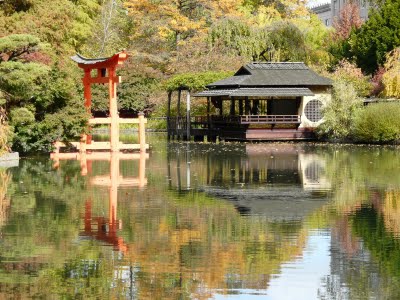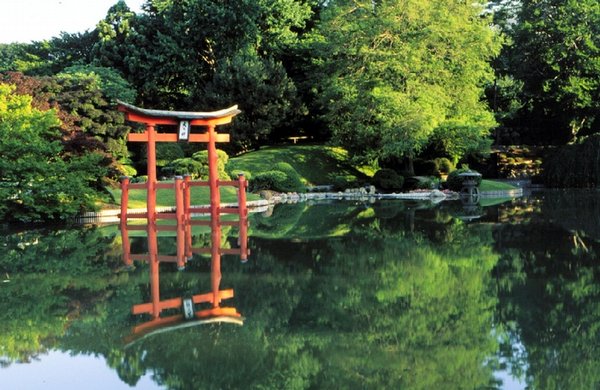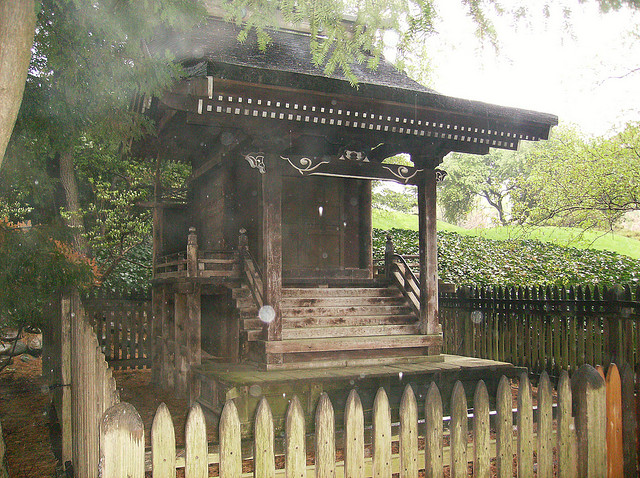New York’s Brooklyn is famous for its ethnic diversity, and it brings to mind many images from popular American movies. One thing you wouldn’t associate it with is a Shinto connection! Yet in its Botanic Garden is an Inari Shrine, established as part of a Japanese section, and the information about it which follows is extracted from two different websites.
***************************************************************************
http://en.wikipedia.org/wiki/Brooklyn_Botanic_Garden
BBG’s Japanese Hill-and-Pond Garden was the first Japanese garden to be created in an American public garden. It was constructed in 1914 and 1915 at a cost of $13,000, a gift of early BBG benefactor and trustee Alfred T. White, and it first opened to the public in June 1915. Widely considered by numerous landscape architects, to be the masterpiece of its creator, Japanese landscape designer Takeo Shiota (1881–1943). Shiota was born in a small Japanese village about 40 miles (64 km) from Tokyo, and in his youth spent years traversing Japan on foot to explore its natural landscape. He emigrated to the United States in 1907.
The garden is a blend of the ancient hill-and-pond style and the more modern stroll-garden style, in which various landscape features are gradually revealed along winding paths. Its 3 acres (1.2 ha) contain hills, a waterfall, a pond, and an island, all artificially constructed. Carefully placed rocks also play leading roles. Among the architectural elements of the garden are wooden bridges, stone lanterns, a viewing pavilion, a torii or gateway, and a Shinto shrine. The pond is filled with hundreds of Japanese koi fish that visitors can enjoy viewing on the tori or along the trail of the garden. Another element that can be discovered walking through the trail is a Japanese temple dedicated to the wolf spirits. A restoration of the garden in 2000 was recognized with the New York Landmark Conservancy’s 2001 Preservation Award
*************************************************************************
http://www.csmonitor.com/1983/0405/040538.html/(page)/2

A scene in the Japanese section of Brooklyn's Botanic Garden (source unknown)
In 1914-15, landscape architect Takeo Shiota assembled a team of assistants to construct the carefully planned juxtaposition of stone, water, bridge, pine, and cascade. Each element is symbolic, and intended to extract the essence of beauty, nature, and life – and harmoniously combine them with one another.
There are no accidents here. The shape of the miniature lake is intended to mimic the contours of the Chinese character for the heart or mind, stepping stones recall tottering steps, a tiny turtle-shaped island and some nearby pines symbolize longevity. On a slope behind the pond is a small Shinto shrine dedicated to Inari, the goddess of rice, whose shrines are usually guarded by two stone foxes. In the lake below, as a watery gate to the jinja or shrine, stands a torii – two upright pillars supporting a curved horizontal beam above a straight crosspiece just below.
This particular torii has a distinguished antecedent, its design being modeled on the much larger original at Miyajima near Hiroshima, which also rises out of the water with particular grandeur. Miyajima is considered to be one of Japan’s three most beautiful sights.
Though the Ryoanji Temple Stone Garden and Roji Garden are temporarily closed while major construction is underway, you might as well know now what you’re missing and make plans for a future visit.
The Ryoanji Temple Stone Garden is in spirit a millenium away from the Hill and Pond Garden. This garden is simplicity itself. There is no water. There are no trees, no plants or flowers, no blossoming Kwanzan cherry trees or weeping willows – only 15 large rocks and a rectangular bed of fine, crushed stone, bordered on three sides by a modest tile-roof wall. On the fourth side is a replica of a portion of a Japanese temple building.
This garden is a precisely proportioned mirror image of the rock garden of one of Japan’s most famous gardens – the Ryoanji kare sansui or dry landscape. The original in Kyoto may date back to 1500, but it existed in obscurity until the 1930s, when it achieved sudden notoriety as a distillation of Zen Buddhist philosophy. Though its temple succumbed to fire twice – once in 1500 and again in the 1790s – the rock garden serenely survived, as it has to the present day.
Next door to Brooklyn’s Ryoanji Garden is one more Japanese-style garden, a roji, the garden path leading to the teahouse so central to Japan’s tea ceremony. The botanic garden’s roji – with its stone lantern, stone pavement and tsukubai or low stone basin for washing one’s hands – perhaps reflects the notions in vogue in the late 16th century, when the roji, formerly merely an entrance to a teahouse, began to develop into a garden.

A copy of Itsukushima's famous torii in Brooklyn's Botanic Garden (photo by Amy A. courtesy yelp.com)


Hi my name is Taha Siraj and I am a student of Milton District High School located in Milton Ontario Canada. I am in grade 11. I am looking for someone to come to my world religions class and speak about Shintoism. We don’t know much about the religion and this would be a great learning opportunty for us.
Please let me know if this is at all possible. And if not, can you please direct me to someone in Toronto or GTA area, who can come and speak to us.
Kind Regards,
Taha
Good day Taha… I would suggest contacting the New York office of the ISF… http://www.internationalshinto.org/isf/contact.php